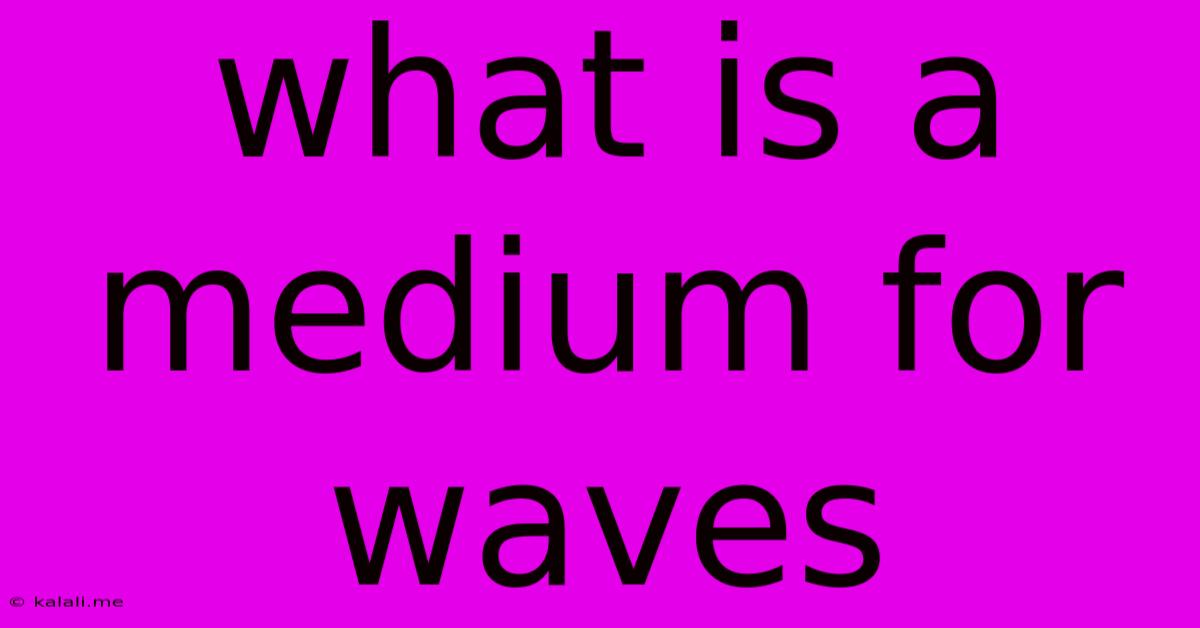What Is A Medium For Waves
Kalali
Jun 07, 2025 · 3 min read

Table of Contents
What is a Medium for Waves? Understanding Wave Propagation
Understanding how waves travel requires grasping the concept of a medium. This article will delve into what a medium is, the different types of media, and how their properties influence wave behavior. We'll explore the nuances of wave propagation through various mediums and clarify common misconceptions.
A medium, in the context of wave physics, is the substance or material through which a wave travels. Think of it as the pathway or channel that facilitates the transfer of energy from one point to another. Without a medium, many types of waves simply cannot exist. This is a critical distinction that separates wave types and helps define their characteristics.
Types of Media and Wave Propagation
Waves can propagate through various media, each exhibiting unique properties that affect wave speed, amplitude, and other characteristics. The three main categories are:
-
Solid: Waves travel efficiently through solids due to the strong intermolecular forces holding the particles together. Sound waves, seismic waves (like those from earthquakes), and even some light waves (in the form of photons interacting with electrons) can travel through solids. The density and elasticity of the solid influence the wave speed. For example, sound travels faster in steel than in wood.
-
Liquid: Liquids also support wave propagation, although generally slower than solids. Sound waves readily travel through liquids, and surface waves (like ripples in a pond) are a common example. The viscosity and density of the liquid affect the wave’s behavior; higher viscosity can dampen wave amplitude.
-
Gas: Gases are less dense than solids and liquids, resulting in slower wave propagation speeds. Sound waves are the most prominent example of waves traveling through gases, like air. The temperature, pressure, and composition of the gas significantly impact the speed of sound.
Mechanical Waves vs. Electromagnetic Waves: A Key Distinction
A crucial aspect of understanding media is differentiating between mechanical waves and electromagnetic waves.
-
Mechanical waves require a medium to propagate. Sound waves, water waves, and seismic waves are all examples of mechanical waves. They transfer energy through the vibration and interaction of particles within the medium. Without a medium to transmit these vibrations, they cease to exist.
-
Electromagnetic waves, on the other hand, do not require a medium. Light, radio waves, microwaves, and X-rays are all electromagnetic waves. These waves are self-propagating disturbances in the electromagnetic field, capable of traveling through a vacuum (like space). While they can travel through mediums like air or water, their existence is independent of a material medium.
The Role of Medium Properties
The properties of a medium significantly affect wave characteristics:
- Density: Denser media generally slow down wave propagation.
- Elasticity: More elastic materials allow for faster wave transmission. Elasticity refers to the ability of a material to return to its original shape after deformation.
- Temperature: In gases, temperature directly influences wave speed. Higher temperatures often mean faster wave propagation.
Understanding Wave Behavior: A Deeper Dive
Understanding the interaction between waves and their medium helps explain various phenomena:
- Refraction: The bending of waves as they pass from one medium to another.
- Reflection: The bouncing back of waves when they encounter a boundary.
- Diffraction: The spreading out of waves as they pass through an opening or around an obstacle.
- Absorption: The decrease in wave amplitude as energy is transferred to the medium.
In conclusion, the medium plays a critical role in the propagation of waves. Understanding the type of medium and its properties is essential for comprehending how waves travel, interact, and behave. The distinction between mechanical and electromagnetic waves further clarifies the necessity and influence of the medium in wave phenomena.
Latest Posts
Latest Posts
-
Can God Be The One Above All
Jun 07, 2025
-
Sudo Apt Get Install Xinetd Tftpd Tftp
Jun 07, 2025
-
Cannot Execute Required File Not Found Linux
Jun 07, 2025
-
How Do You Write Song Lyrics In An Essay
Jun 07, 2025
-
What Does It Mean When Someone Age Is M
Jun 07, 2025
Related Post
Thank you for visiting our website which covers about What Is A Medium For Waves . We hope the information provided has been useful to you. Feel free to contact us if you have any questions or need further assistance. See you next time and don't miss to bookmark.